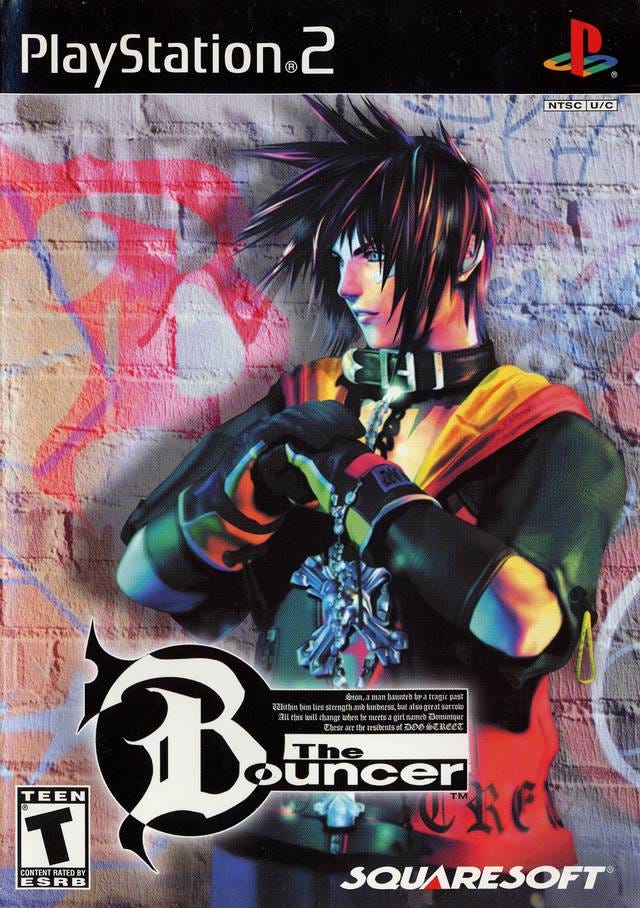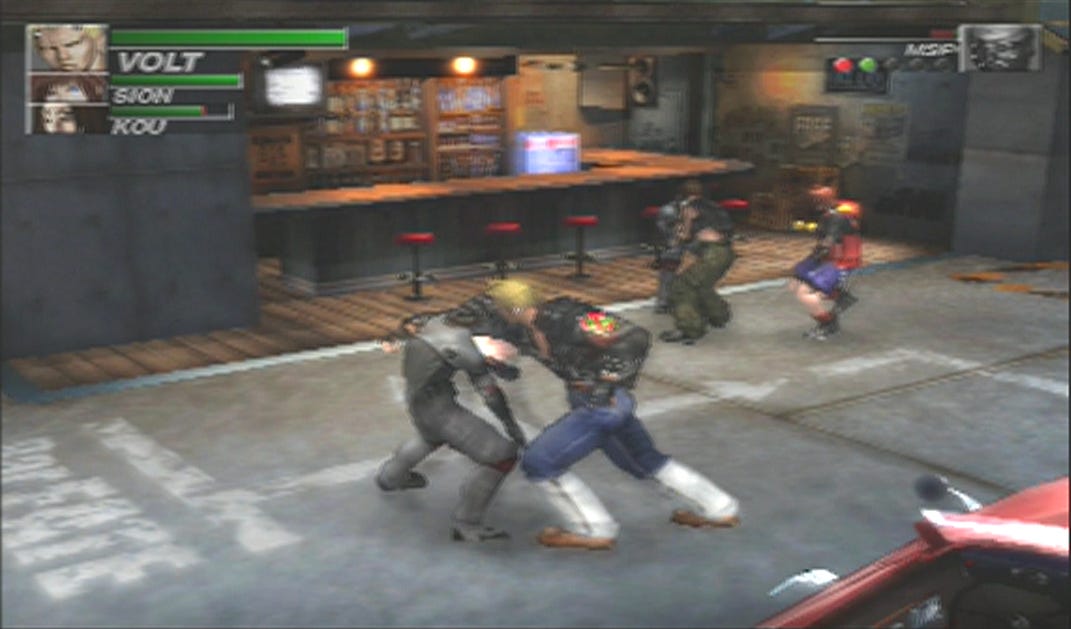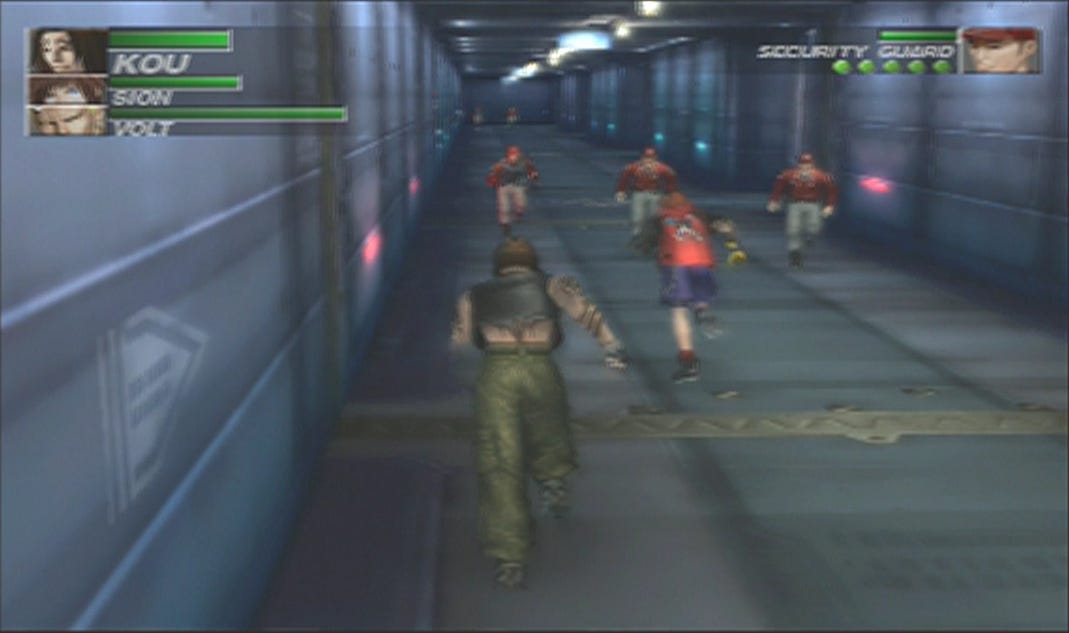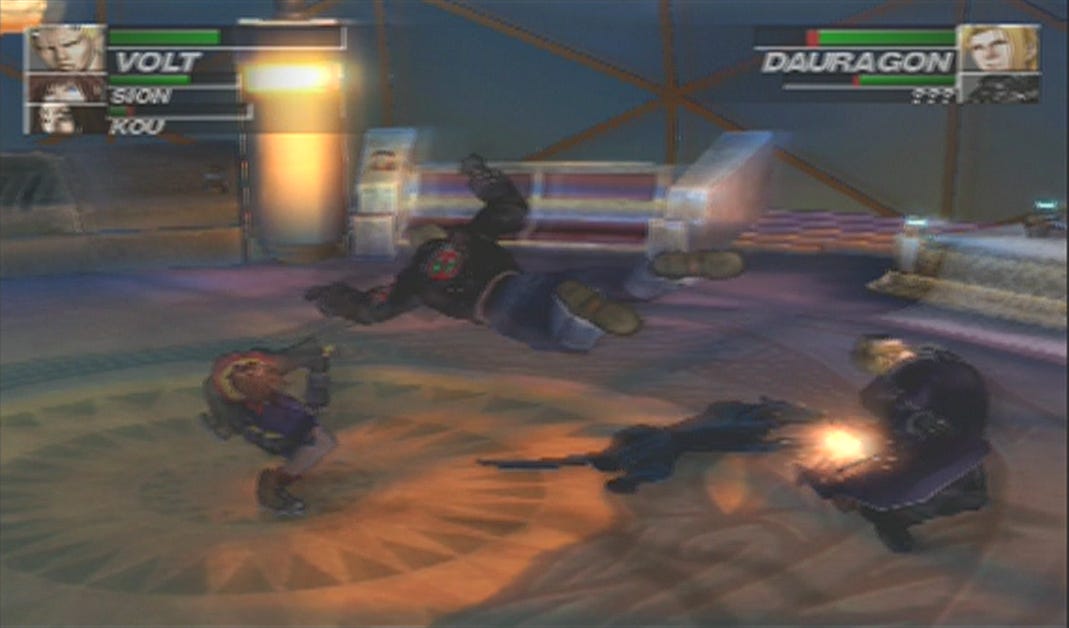The Bouncer is SquareSoft's Long Forgotten Beat-Em-Up Tech Demo
That you should absolutely play
What even is The Bouncer.
A miserable pile of secrets? Almost.
The Bouncer is SquareSoft's first step into a Brave New World with the PS2. “Play the Action Movie,” the back of the box reads. This tagline sums it up. More than any other PS2 game I've ever played, The Bouncer is a CG film with clunky brawling tacked on.
Don't read that like it's a bad thing. Heavens no. The Bouncer is a work of crazed early 2000s art.
For starters, the game is called The Bouncer. The three characters you control are, indeed, bouncers at a bar (the bar is called Fate and is located on Dog Street – we're just getting warmed up). But do you actually bounce anyone? No. At one point, the three bouncers fight some Special Forces inside Fate after they kidnap your fly girl, but that's all. They don't stop bar brawls. They don't keep minors from getting in the bar. They just look tough, and even that's questionable. Perhaps SquareSoft and/or developers Dream Factory were trying to provide some commentary on how we're all bouncers in the game of life, but I doubt it.
I'm not going to review The Bouncer so much as tell you why you should play it. First up: game named The Bouncer, no actual bouncing. Brilliant! Second, main character Sion Barzahd (his Christian name, no doubt) is totally a test run for Sora from Kingdom Hearts. Both characters were designed by Tetsuya Nomura, and it's just unmistakable. Third, you can beat the game in about 90 minutes. That's with watching all the loading screens, the unbelievable amount of cutscenes, saving the game after every fight, etc. This sounds short (and it is), but it's the perfect amount of “bouncing.”
But wait, there's more! The brawling is stiff and awkward, but the more you play, the more it grows on you. I can't explain the latter, other than perhaps a bit of Stockholm Syndrome. There's always slight lag between inputs, both for you and the computer, so button mashing is out of the question. Sometimes the computer-controlled opponents just stand there and absorb all your hits. Other times, they grow a pair and absolutely destroy you. The more opponents you take down, the more points you gain. Points are used to increase your life, attack, or defense, or unlock new moves.
For such a short game, The Bouncer goes everywhere. One minute, Sion and his boys Volt and Kou are wasting time at the bar. The next, they're at the shadowy Mikado corporation, fighting off genetically engineered dobermans and hijacking flying vehicles. They meet Echidna, a scantily-clad woman from Volt's past who really wants to beat him down, but can't. The bouncers eventually blast off into outer space to stop the main villain, Dauragon, from blowing up the city with a satellite. A mysterious female character turns into a panther. Sion whines a lot. There's also one gigantic plot twist that I did not see coming. You better believe I'm not revealing that here.
If The Bouncer slams its big mighty fist into your heart, you'll want to play through the game multiple times to upgrade every character to 'A' rank. Once that's complete, you can play Survival Mode, where you take on fifty enemies across ten stages. After each stage, your health doesn't go back up and the enemies keep getting harder. Finally, The Bouncer is compatible with the Multitap, for a Battle Royal mode. Personally, I wish SquareSoft would have gone all the way and made an unlockable VS fighting game with Bouncer characters a la Ehrgeiz, but alas.
The Bouncer had some hype back in early 2001. The game looked absolutely gorgeous in those EGM and Game Informer screenshots, and all signs pointed to it being another SquareSoft slam dunk. Once The Bouncer released, however, disappointment quickly set in. Reviewers were floored by the graphics, but felt the game lacked substance. The short length, mediocre controls, and poor camera angles were some of the main complaints across all outlets.
All those early 2001 gaming journalists are spot on in their assessments of The Bouncer, but I don't care, I love it anyway. I have a soft spot for games as balls crazy as The Bouncer because, frankly, they don't make 'em like this anymore. Some might say that's a good thing, but I wish some AAA studios would take more chances and throw $10-20 million dollars at some bizarre experimental nonsense (pour one out for Death Stranding). If they make money, great, if not, at least they tried something different.
The Bouncer is nothing if not different. It's ostensibly a beat-em-up, but really, it's just a bonkers CG anime with some occasional fighting and light RPG elements. At the time of its release, I thought little of it. It was hyped, it came, and it went, like so many games before it. But now, 20+ years after its North American release, I recognize its absurdity. Can you imagine Square Enix releasing a “Action Movie” with a short play time that costs tens of millions of dollars for the Playstation 5? Of course not, they're a safe, conservative company now. No time for madness, focus on the top-dollar franchises and screw the rest.
The Bouncer isn't Squaresoft's finest hour, and it feels more like a tech demo than an actual game, but I'm glad it exists. The game's a monument to a time when publishers would take risks on development studios’ freewheeling, creative impulses. I hope we all live to see such a day again.










Awesome stuff dude, lots of Great memories
Never heard of this one, seems interesting if I ever have a chance to play it.
It seems that there was a golden age of Square's experimentation both into new genres and in new RPGs beyond its established franchises, which I miss. The new RPGs all tried new ideas in both storytelling and game mechanics -- nothing was a mere reskin of a Final Fantasy game. I guess this era peaked with the PS1 but spilled over some into the PS2.
The merger with Enix might have contributed to what Square is now; Final Fantasy and Dragon Quest under a single roof meant two big franchises to harvest and not as much energy to plant new seeds. Also there are now decades of nostalgia to exploit, for a genre (JRPGs) that is otherwise past its prime.